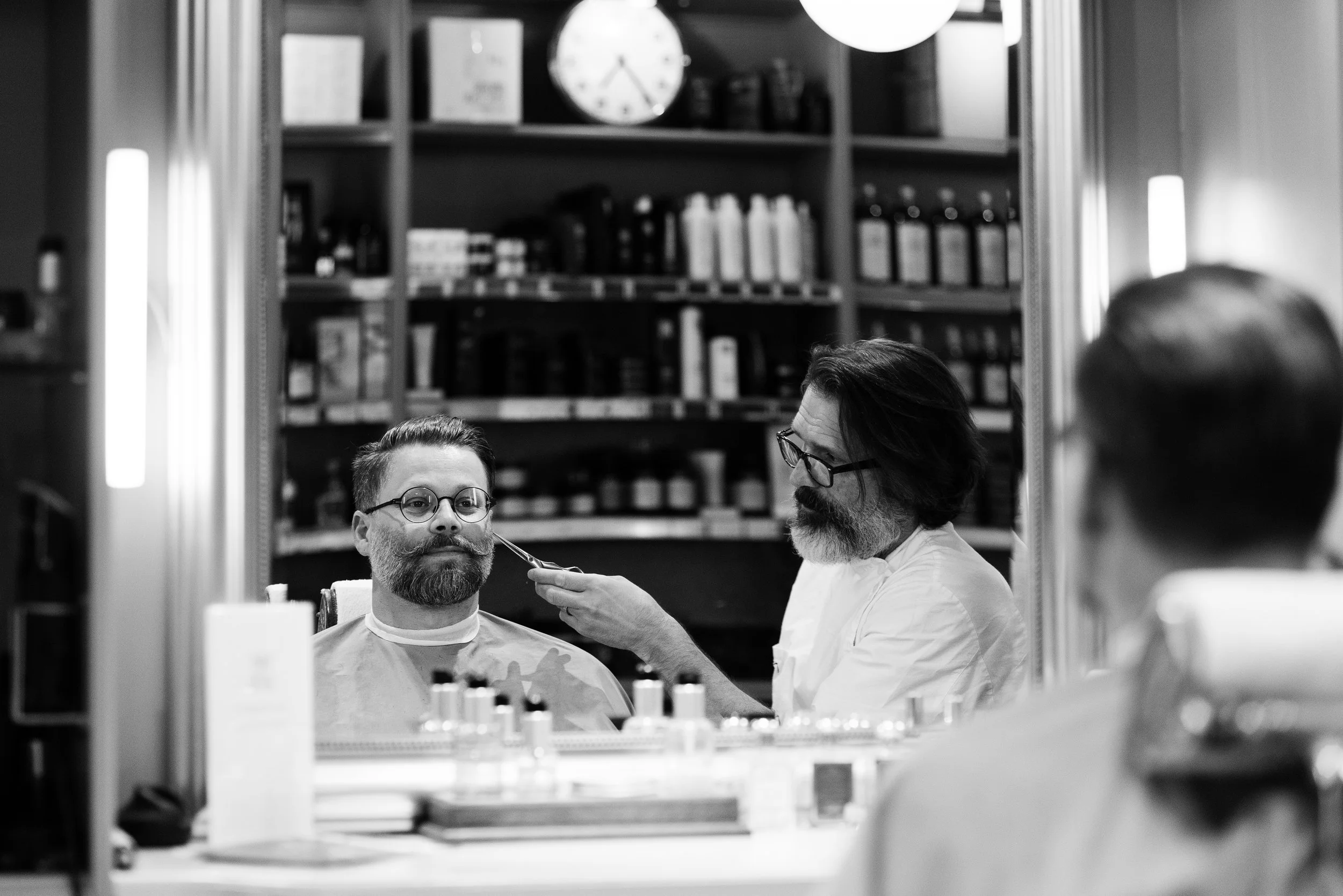Stockholm by Patric Wallertz
With swept back hair and a pointy beard not unlike a modern day Viking adorned in designer glasses, Patric Wallertz is far from what I expected as Head of Design for uber chic raincoat label Stutterheim. 46 and father to two, his black coat flutters about him in a wizard-like manner. Having left Uniform for the Dedicated last year, he’s played a bold move in pushing Stutterheim towards new dimensions. To dig into the quality of the man, we meet for lunch and begin an afternoon long conversation that stretches through Patric’s version of Stockholm, replete with beard trim and Swedish Fika.
© Louie Thain
It’s a rare and crisp blue-skied summer day in Stockholm and the table on the outstretched wing of restaurant Eriks Gondolen provides an omniscient view over the city. Some critics have passed it off as an old fashioned spot though that doesn’t stop Patric from relishing the elegance of a perfectly renovated 1960s interior. Tailored business suits convene for lunch, and a couple of young models lounge in Nordic goddess-like manner on green leather Chesterfields. The bar supposedly sports the best cocktails in town.
Scene 1: “I hated wine” at Eriks Gondolen
The combination of savoury cuisine, a delicious view, and comfortable company has Patric chattering away on his keen interest in gastronomy and wine. Which of course, all began in Italy. “I moved to Florence when I was twenty, and lived there for three years. Before that, I had no interest in food and didn’t like red wine. I thought it was awful stuff! But during those years, everything grew on me and it became a part of everyday life.”
Reminiscing on those bygone Florentine days, Patric recalls walking into a scooter shop two days in and blasting out on a Vespa, hell bent for Luisa Via Roma. “At the time, Dolce&Gabbana had just released their first or second collection. It was based on Italian peasant farmers so it was knitted jumpers and high men’s trousers with big suspenders. I bought two sweaters and blew all my money!” he laughs with a devilishly proud grin.
Scene 2: Barber & Books
Clearly, Patric isn’t one to neglect the finer details of his visage. So post-lunch, he strolls through sunny Södermalm towards the regal-sounding Barber&Books establishment owned by master barber Håkan Ström who begot the city’s rising trend of new generation barbershops. His wares sparkle on the far back wall, setting a gentlemanly backdrop as Patric lowers himself comfortably into the barber’s chair.
One gets the sense that Patric retains a boyish open wonder for all things beautifully detailed, from a good beard trim to (apparently) spoons and fighter jets. “This is because in Sweden where I’m from, you get a little spoon when you’re baptised, engraved with your weight, length, and time of birth. I’ve always thought about the surface and shape of that spoon, which I’ve had with me since I was six or seven.” And who of us haven’t had a fascination with jet planes in our boyhood days?
“Now they look a bit shit but back in the day, they looked fantastic!” Today, he’s quite keen on other modes of speedy transport. “It has a depressing story actually. I was eight years old when the only good Swedish Formula One driver – ‘SuperSwede’ Ronnie Peterson – was killed at Monza. I saw that on television and since then, I’ve been hooked on Formula One.”
Scene 3: Melancholic State of Mind
Originally from the coastal town of Gothenburg, Patric also holds a dear relationship to the landscape of his country. “In summer you swim in the ocean or in nearby lakes. In spring and autumn you have the rain every day, sometimes for weeks. And in the winter you have snow. So I love the coast, the islands, and the horizon.”
That inherent connection to the Swedish wilderness suits him well at Stutterheim, a brand with the most unusual motto: Swedish melancholy at its driest. “In Scandinavia during the rainy periods, it’s dark, grey and mostly cold. So that melancholic feeling and state of mind is never far away,” reflects the designer. “It comes and visits me many times through the year and weeks.”
For this man, melancholy transcends an emotion and becomes a fashion aesthetic for Stutterheim. “It’s in my mind. It’s clean, filled with purpose, and is a serious look.” Filled with purpose? “Well there must be a usefulness to the garment; it has to have a purpose to exist. Just doing it for the sake of fashion is not interesting.” Quite apropos of him to work on rainwear in a context that sees an average of 160 days per year of rainfall.
Scene 4: Subtle Stutterheim
It’s at the Stutterheim Flagship Store, a refreshingly airy space devoid of any unnecessary gimmicks, where Patric’s work command full attention. They line up neatly on either side of the space. A titanic mirror door to the right allows for one’s own reflection whilst trying on a Stutterheim piece. The designer himself takes stock of a few pieces and intones: “Pretty much everything in fashion comes from old military clothing and then you tweak it, adjust, and put it in a different fabric.”
His personal design recipe is built upon iconic military uniforms that he shapes in several ways. Such as “the Field Jacket, the MA-1 Bomber, the Overcoat, the Trench, the Pea Coat, the Barracuda, the G9 Jacket, and the classic Anorak with the hood and the pocket on the breast.” Well versed in his repertoire of coats, his artistry is then found in the balance of garment volume, fabric choice, and detailing. Examining the collection of minimally elegant rainwear, Patric’s words take quick meaning.
Scene 5: Swedish Fika
However, his design process is far more complex and calculated than it appears. Over Fika - a Swedish tradition of gathering for coffee - at the nearby il caffè söder, Patric explains: “Stutterheim is a minimalistic expression of things. We won’t add more than ONE fabric per season. Otherwise, it goes away from our image and origins. This however means that it requires a lot more of our time to investigate and choose the correct fabric. It’s slow fashion.”
Having joined the team a year ago, a predominant textural focus to rubber was “a bit demanding and one-dimensional at first glance.” But with the aforementioned research and time spent with the Stutterheim repertoire, Patric seems resolute to the challenge. “I think I’ve found a good relationship to the fabric now.” The most recent brand development is Patric’s insertion of a cotton fabric – “an organic fabric with the same movement as rubber. For the next season, we will add a lighter version of water repellent, lighter, and flexible fabric.” He hopes the consumer will recognise Stutterheim heritage, while taking a step forward in the brand’s evolution.
A quick Internet search won’t reveal much more about this designer shaping the next generation of Stockholm’s Stutterheim Raincoats. This city is where Patric met his wife, where his kids were born, and where he’s spent the past fifteen years of his professional life. For him, belonging to this city is about “being well educated and having a career, as well as living a fast pace life and being sensitive to trends.” And most importantly to “NOT be from Stockholm.” With that he shoves his hands into his coat and heads home to his family, cheerfully disappearing into the stark blue of a slow approaching Scandinavian evening. Perhaps next week his melancholy will revisit him together with the rain.
Exclusive for GQ Portugal
www.stutterheim.com

